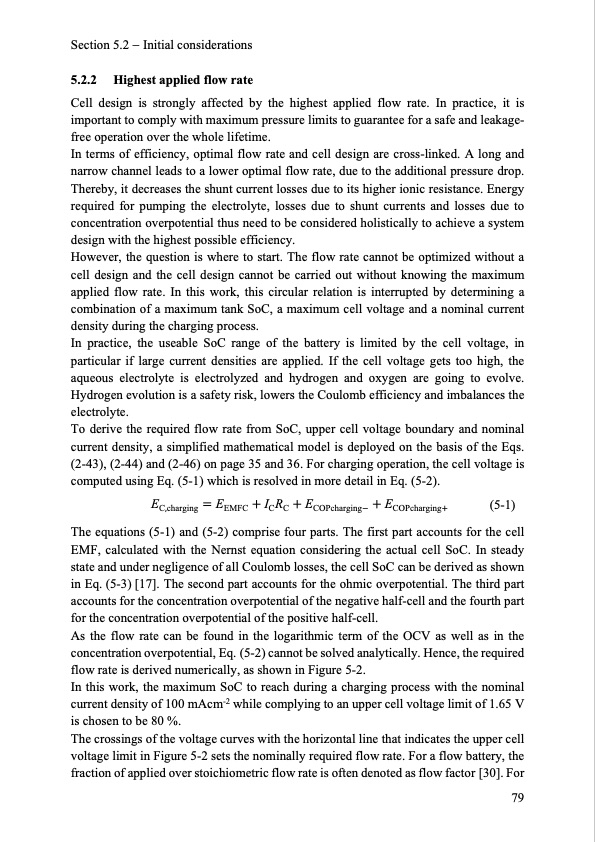
PDF Publication Title:
Text from PDF Page: 087
Section 5.2 Initial considerations 5.2.2 Highest applied flow rate Cell design is strongly affected by the highest applied flow rate. In practice, it is important to comply with maximum pressure limits to guarantee for a safe and leakage- free operation over the whole lifetime. In terms of efficiency, optimal flow rate and cell design are cross-linked. A long and narrow channel leads to a lower optimal flow rate, due to the additional pressure drop. Thereby, it decreases the shunt current losses due to its higher ionic resistance. Energy required for pumping the electrolyte, losses due to shunt currents and losses due to concentration overpotential thus need to be considered holistically to achieve a system design with the highest possible efficiency. However, the question is where to start. The flow rate cannot be optimized without a cell design and the cell design cannot be carried out without knowing the maximum applied flow rate. In this work, this circular relation is interrupted by determining a combination of a maximum tank SoC, a maximum cell voltage and a nominal current density during the charging process. In practice, the useable SoC range of the battery is limited by the cell voltage, in particular if large current densities are applied. If the cell voltage gets too high, the aqueous electrolyte is electrolyzed and hydrogen and oxygen are going to evolve. Hydrogen evolution is a safety risk, lowers the Coulomb efficiency and imbalances the electrolyte. To derive the required flow rate from SoC, upper cell voltage boundary and nominal current density, a simplified mathematical model is deployed on the basis of the Eqs. (2-43), (2-44) and (2-46) on page 35 and 36. For charging operation, the cell voltage is computed using Eq. (5-1) which is resolved in more detail in Eq. (5-2). EC,charging EEMFC ICRC ECOPcharging ECOPcharging (5-1) The equations (5-1) and (5-2) comprise four parts. The first part accounts for the cell EMF, calculated with the Nernst equation considering the actual cell SoC. In steady state and under negligence of all Coulomb losses, the cell SoC can be derived as shown in Eq. (5-3) [17]. The second part accounts for the ohmic overpotential. The third part accounts for the concentration overpotential of the negative half-cell and the fourth part for the concentration overpotential of the positive half-cell. As the flow rate can be found in the logarithmic term of the OCV as well as in the concentration overpotential, Eq. (5-2) cannot be solved analytically. Hence, the required flow rate is derived numerically, as shown in Figure 5-2. In this work, the maximum SoC to reach during a charging process with the nominal current density of 100 mAcm-2 while complying to an upper cell voltage limit of 1.65 V is chosen to be 80 %. The crossings of the voltage curves with the horizontal line that indicates the upper cell voltage limit in Figure 5-2 sets the nominally required flow rate. For a flow battery, the fraction of applied over stoichiometric flow rate is often denoted as flow factor [30]. For 79PDF Image | Model-based Design Vanadium Redox Flow Batteries

PDF Search Title:
Model-based Design Vanadium Redox Flow BatteriesOriginal File Name Searched:
10-5445IR1000070670.pdfDIY PDF Search: Google It | Yahoo | Bing
Salgenx Redox Flow Battery Technology: Salt water flow battery technology with low cost and great energy density that can be used for power storage and thermal storage. Let us de-risk your production using our license. Our aqueous flow battery is less cost than Tesla Megapack and available faster. Redox flow battery. No membrane needed like with Vanadium, or Bromine. Salgenx flow battery
| CONTACT TEL: 608-238-6001 Email: greg@salgenx.com | RSS | AMP |